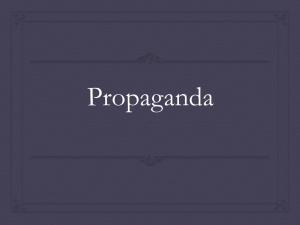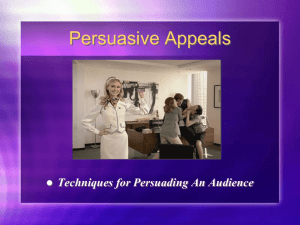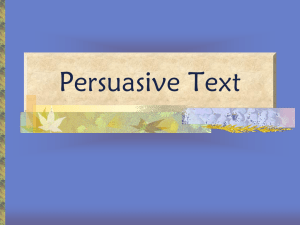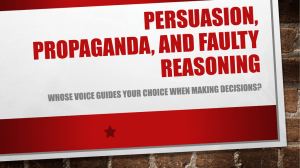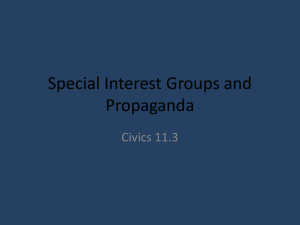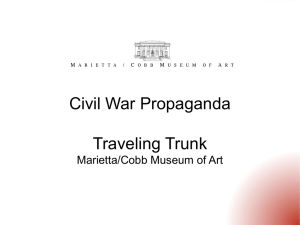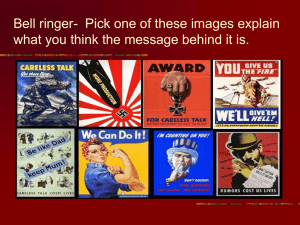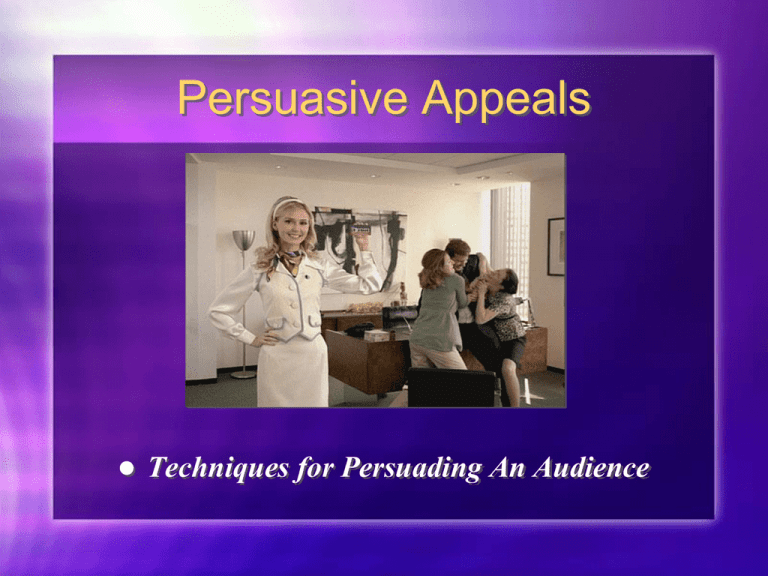
Persuasive Appeals
Techniques for Persuading An Audience
What is a Persuasive Appeal?
An argument that a
speaker/writer directs
toward a certain
belief/feeling or attitude
that his/her audience
holds
Allows speaker/writer to
tailor his/her argument
in the best possible way
according to his/her
audience’s needs/desires
Three Types of Persuasive
Appeals:
BASED ON
ARISTOTLE:
Appeal to ETHOS
Appeal to PATHOS
Appeal to LOGOS
Appeals to ETHOS (ETHICAL):
-Based on the
authority/credibility of the
writer
-Writer must convince the
audience of his/her good
character, good sense, and
good motives
-Created through known
experience, expertise,
credentials/certification,
polished presentation of
material
Appeals to Pathos (EMOTIONS):
-uses emotions to persuade
-attempt to persuade by making reader/listener feel guilt,
love, security, greed, pity, humor, etc.
-shown through vivid, emotional language, and sensory
details
-are sometimes dangerous—when used as the main support
for an argument, they may be masking weak arguments
Appeals to Logos (LOGIC):
-normally considered most
effective appeal
-based on the logic, facts,
and evidence, which is
usually considered to be
most important to
readers/listeners
-shown through details,
statistics, expert testimony
of a credible source, facts,
definitions, witness
statements
Persuasive Appeals Gone Bad=
Logical Fallacies/Propaganda
Techniques
Sometimes writers use
propaganda techniques
to intentionally
mislead their audience
in order to sell an idea
or project.
A logical fallacy is an
invalid argument
Types of propaganda
Techniques/Logical Fallacies
Name Calling
Bandwagon
Emotional Appeal
Testimonial
Repetition
Sweeping Generalization (Stereotyping)
Glittering Generalities
Plain Folks
Snob Appeal
Sex Appeal
Facts and Figures
Magic Ingredients
Slogans/Catchwords
Logical Fallacy/Propaganda
Technique #1= Name Calling
Name calling=
attacking a person or
product instead of an
issue
Used frequently in
political campaigns
Gives a bad name to
an opponent or
product (typically
without any proof)
Logical Fallacy/propaganda
Technique #2= Bandwagon
A bandwagon appeal tries
to persuade the reader to
think, do, or buy
something because it is
popular or because
“everyone” is doing it.
Examples: Four out of five
people use Colgate
Toothpaste. Over 2 Billion
Served at McDonalds...."
Logical Fallacy/Propaganda
Technique #3= Testimonial
A testimonial
attempts to persuade
the reader by using a
famous person to
endorse a product or
idea
Also known as
celebrity/famous
propaganda
Logical Fallacy/Propaganda
Technique #4= Emotional Appeal
An emotional appeal tries
to persuade the reader by
using words that appeal
only to the reader’s
emotions instead of to
logic or reason.
Purposely uses words to
make you feel strongly
about something (any
range of emotions,
including humor)
Appealing to humor is an
emotional appeal
Logical Fallacy/Propaganda
Technique #5= Repetition
Repetition attempts to
persuade the reader by
repeating a message over
and over again.
Repetition CAN be an
effective persuasive
technique when combined
with other elements of a
solid argument, but
relying ONLY on
repeating an idea is never
very convincing
Logical Fallacy/Propaganda Technique
#6= Stereotyping
Stereotyping makes
an oversimplified
statement about a
group based on limited
information.
Attacks or makes
assumptions about one
group of people
Logical Fallacy/Propaganda Technique
#7= Glittering Generalities
Glittering generalities uses
vague, sweeping
statements
Typically used in politics;
they appeal to honor,
glory, love of country,
desire for peace, freedom,
and family values
They sound great, but you
don’t always know what
they mean
Logical Fallacy/propaganda Technique
#8= Plain Folks
Plain folks uses images of people "just like you.”
Appeals to ordinary people because of the use of
dress, speech, or action
Often used in politics and advertising to show the
“leader” is simple, just like you
Logical Fallacy/propaganda Technique
#9= Snob Appeal
Snob appeal plays on our desire for fancy
things and the "good life".
Examples include jewelry, expensive cars,
perfumes, designer clothing and accessories
are often marketed using snob appeal.
Logical Fallacy/propaganda Technique
#10= Sex Appeal
Sex appeal uses sex to sell a product or idea.
Examples include beer commercials, car ads, or
rock videos (to name a few.)
Logical Fallacy/propaganda Technique
#11= Facts and Figures
Facts and figures uses statistics and factual
information is used to prove why the product is
the best
Logical approach to advertising and persuasion
Logical Fallacy/Propaganda Technique
#12= Magic Ingredients
Magic ingredients makes a suggestion that some
almost miraculous discovery makes the product
exceptionally effective
Ex: A pharmaceutical manufacturer describes a
special coating that makes their pain reliever less
irritating to the stomach than a competitor`s.
Logical Fallacy/Propaganda Technique #
13=Slogans and Catchphrases
Slogans are catchwords or phrases that are loaded with
emotion
They are often loaded with emotion
A clever approach to selling a product
Often use repetition (throughout all their ads and
commercials for example) and/or they just stay with you
for a long time


